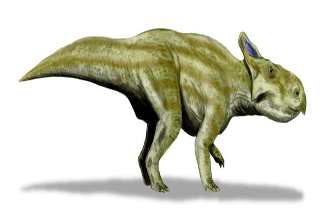
Montanoceratops Dinosaur is a genus of herbivorous dinosaur that lived during the Late Cretaceous period, approximately 75 to 74 million years ago. It belongs to the family Ceratopsidae and is known from fossil remains found in Montana, United States. Montanoceratops was a smaller ceratopsian, measuring around 3 to 4 meters (10 to 13 feet) in length and weighing about 500 to 700 kilograms (1,100 to 1,500 pounds).
One of the distinctive features of Montanoceratops was its skull, which was adorned with a variety of bony structures. It possessed a short frill at the back of its skull, with several small knobs and spikes extending from it. Additionally, Montanoceratops had a pair of brow horns above its eyes, although these were relatively short compared to other ceratopsians.
Montanoceratops Facts :
| Name: | Montanoceratops Dinosaurs |
| Size: | 3 to 4 meters |
| Main Facts: | Montanoceratops is a genus of herbivorous dinosaur that lived during the Late Cretaceous period, approximately 75 to 74 million years ago. |
The shape and structure of its skull suggest that Montanoceratops had a beak-like mouth at the front, which it used to crop vegetation. It had numerous teeth in the back of its jaws, specifically adapted for grinding plant material. These dental adaptations indicate that Montanoceratops was a herbivore, feeding on low-lying plants such as ferns, cycads, and conifers.
Montanoceratops had a sturdy body supported by four robust legs, which ended in hooves. Its tail was relatively short compared to its body length. Fossil evidence suggests that Montanoceratops may have lived in herds, similar to other ceratopsians. This social behavior likely provided protection against predators and facilitated mating rituals. As a Late Cretaceous dinosaur, Montanoceratops coexisted with other iconic species like Tyrannosaurus rex and Triceratops. Its bony frill and horns may have served as defensive features, deterring predators or engaging in intra-species combat during mating contests.